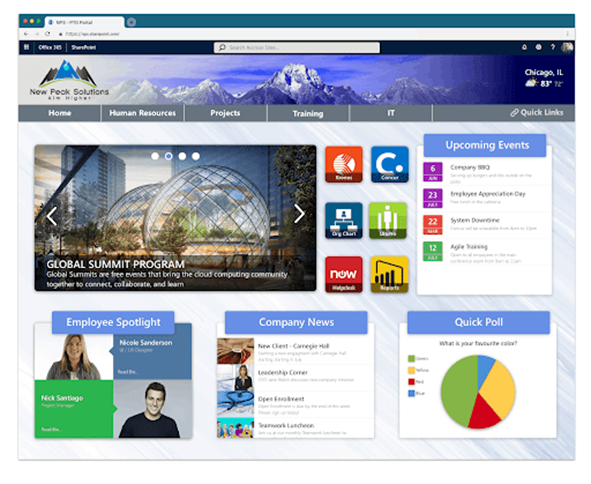SharePoint Intranet vs. Extranet: What’s the Difference?

You’ve probably heard the terms intranet and extranet, but what do they really mean and is this a business solution that your business needs to consider?
What is an intranet?
A corporate intranet is private network available via a web browser and is designed to improve communication and collaboration. There are several ways to leverage an intranet for your business.
SharePoint Online is one of the most popular intranets for businesses out there today and is widely adopted by businesses large and small because it's one of the many applications with your Office 365 subscription.
SharePoint Intranet Homepage
Think of an intranet like secure website that is not available to the public and undetected by Google. It requires login information to access your intranet site.
Most intranets have an intranet home page, serving as a central location where employees can visit to get all important business announcements. Here are a few examples.
- Welcome your latest hires
- Celebrate client acquisitions
- Announce open enrollment period for benefits with all of the relevant documents included here
- Scheduled company events
- Publish photo albums from your latest holiday party
- Poll your employees about when and where to have the next Happy Hour event

As you can see, you start to establish an online corporate culture, a place where your employees can gain a sense of togetherness despite physical separation.
Your homepage can serve as a repository of your most used sites and templates:
- Employee documents (employee manual, annual review forms, etc.)
- Employee PTO request form
- Stationery (letterhead and hi-res logos)
- Links to all of your business applications
- Training videos
- And more
This will undoubtedly make for a better experience for new hires and save time for your admin team.
Department Sites
Each department or business unit has its own site which serves as a document library.
Think of your SharePoint intranet has a modern file server and each document library is a folder within your network with very granular customizations for employee access – down to the file.
SharePoint not only serves as a well-organized online file system for your employees, they can also encrypt and share documents directly from SharePoint with the outside world – using links - while adhering to your compliance and security settings.
There are tremendous business benefits when you migrate your file server to SharePoint Online. For one, you never have to buy another file server again. All of your files are accessible through a secure, web browser and are structured just like your existing folder system. This comes with your Officer 365 subscription and if you're not leveraging SharePoint online, then you're not getting your money's worth from MS365.
Leverage Microsoft Teams Meeting & Microsoft Phone System
SharePoint is also the backend to your Teams application. With bilateral syncing setup between the 2 applications, your employees can now access their department documents in Teams along with video, phone, chat, etc. making it quick and easy to collaborate with employees, clients, partners and vendors alike.
This on-demand access to everything you need to stay productive is what Microsoft 365 is all about. And the best part about It is that it’s free with your Office 365, so will save you time and money and extend your ROI.
There is a ton of integration options with SharePoint Online to customize your experience even further.
An intranet’s key functionality includes:
- Employee information management. Keep your personal and professional information updated so your administrators don’t have to.
- Content management. Create, modify and publish content (e.g., documents, news, guides, policies)
- Project and task management. Project teams can use an intranet to track project and tasks, including progress, deadlines, related documents and discussions, and more.
- Employee collaboration and communication. Use SharePoint document libraries in tandem with Teams and collaborate on a document together real-time – with easy access to your communication tools (e.g., instant messaging and video conferencing) in one location.
- Knowledge management. Intranet users can process, store, improve, make corporate knowledge easily accessible and actively reused.
- Learning management. Intranets provide creating, scheduling and delivering trainings to employees, including knowledge assessment and certification. Employees can enroll into a relevant training via an intranet.
- Employee self-service. Employees can submit various requests (e.g., vacation, equipment maintenance, training) via an intranet and track their fulfillment.
- Social features. These intranet features help improve employee engagement and motivation. They include integration with social media, forums, blogs, mentions, comments, likes, surveys, communities, and gamification features like badges, points, and leaderboards.
What is an extranet?
Extranets connect organizations with their suppliers, customers, business partners, or other third parties. They help engage external participants in internal business processes, for example, to streamline procurement operations and support a real-time supply chain.
One extranet scenario that is common is the use of document management for clients. By assigning your clients a secure login, they can gain access to their profile, access forms and documents, and upload information to their profile.
An extranet, in its turn, can enable remote collaboration with your customers, vendors and partners and save the time and efforts of all the parties via automation and creating full visibility into the collaboration process.
An extranet’s key functionality includes:
- Collaboration with partners. These features include bid management, vendor assessment and approval workflows, and more (for vendor portals).
- Communication with customers and customer self-service. Customers can place service requests and track their resolution, find answers to their questions about your product or service in a knowledge base, exchange ideas and opinions about your brand via discussion boards.
- Facilitated business process management. Extranets allow automating processes like vendor assessment and approval, order placement, billing, and more. Besides, your customers and partners get access to the information you want to share with them without calling or emailing you.
- Corporate and personal data safety. An extranet is a more secure way to exchange data than, for example, an email, as it offers granular access control, multifactor authentication, encryption of data at rest and in transit, audit trail, and other security measures.
- Improved visibility into business operations. With an extranet, you can see every action taken, let’s say, during the order fulfilment, as well as who did them. This makes the whole process traceable and enhances quality control.
If you're looking to create an intranet or extranet in SharePoint, ANP can help.
As a Microsoft Gold Partner, ANP is focused on helping small and mid-size businesses adopt Microsoft 365 and Azure and position them for future growth. We will not only migrate your on-premise files to the cloud, but we will provide ongoing SharePoint support services.
Contact us today to discuss what you're looking to achieve and we can help you determine if SharePoint is the right solution for your business need and get the process started.


